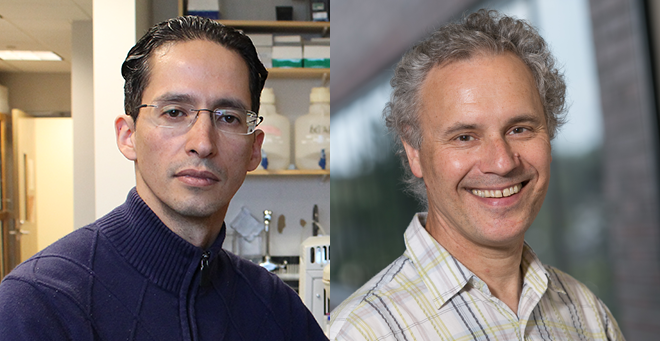A new study by Alejandro Vasquez-Rifo, PhD, and Victor Ambros, PhD, shows that certain strains of Pseudomonas aeruginosa, a rod-shaped bacterial pathogen that causes disease in plants and animals, including humans, have a unique mechanism for disabling and degrading the ribosome in its host cells. The study, published in PLOS Biology, points to a mechanism that may be harnessed by scientists in the lab or by clinicians to target tumor cells or perhaps even block the mechanisms that make certain pathogens virulent.

“What we’ve found is an unexpected weapon in a pathogen’s arsenal that disables the host defenses by stabbing right at the heart of the ribosome,” said Dr. Ambros, the Silverman Chair in Natural Sciences and professor of molecular medicine. Ambros was co-recipient of the 2008 Albert Lasker Award for Basic Medical Research for his co-discovery of microRNA, the very short, single-stranded RNA molecules that are now understood to play a critical role in gene regulation.
“If we can understand how the P. aeruginosa cleaves and disables the ribosome, it is possible that we could use this biological process as a potential therapeutic to disable protein synthesis in tumor cells,” said Dr. Vasquez-Rifo, a postdoctoral fellow in the Ambros lab, who initiated the research.
Ribosomes are molecular machines found in all living cells. They are responsible for synthesizing and making the proteins a cell needs to carry out its functions. Ribosomes build proteins by assembling and linking amino acids together in the order specified by messenger RNA (mRNA) molecules, forming chains. Sometimes referred to as the translational apparatus, ribosomes consist of two subunits, both made up of RNA and proteins.
When Vasquez-Rifo began this project, he wasn’t looking at ribosomes at all. He was interested in understanding how the stress of exposing the nematode C. elegans to a common bacteria, P. aeruginosa, would impact nematode microRNAs. An odd finding in the data during a quality assurance test, however, prompted him to change the trajectory of his research. After purifying RNA from worms exposed to the bacterium, Vasquez-Rifo found that ribosomal RNA was seemingly being cleaved, or cut, into two large chunks and he couldn’t explain why. He suspected, given the size of the RNA fragments he was seeing, that the entire ribosome was under attack and being broken.
“This project is a good example of an investigator taking an unexpected observation and following up on that result,” said Ambros. “When you see something in a system that is unknown, you have to make a decision, as a scientist, if it’s worth following up and pursuing further.”
Vasquez-Rifo suspected that P. aeruginosa was disabling the protein making apparatus so that the C. elegans cells couldn’t mount a defense to the bacteria.
“We had a reasonable hypothesis we could test,” said Vasquez-Rifo. “And we had an expectation that there were important insights to be gained about the fundamental working and nuances of protein synthesis if we pursued this avenue of research.”
Vasquez-Rifo was able to determine that worms fed P. aeruginosa—a common experimental method of introducing a pathogen into C. elegans—exhibited two prominent segments of RNA that were not observed in control worms fed with E. coli, the regular lab diet of C. elegans. These segments of RNA turned out to result from the accumulation of ribosomes cleaved at helix 69 (H69). Additionally, the P. aeruginosa-induced ribosome cleavage was tightly associated with the expression of the zip-2 mRNA, a critical component of a pathway that is activated by worm cells when protein synthesis goes awry. This confirmed that P. aeruginosa-exposed worms were indeed suffering from inhibition to the protein translation apparatus.
Further experiments by Vasquez-Rifo confirmed that this breakdown was happening independently of other pathogenic toxins of P. aeruginosa.
Strangely, not all strains of P. aeruginosa employed this mechanism of attacking the ribosomes. Of the 52 strains of P. aeruginosa that Vasquez-Rifo tested, only about half elicited the ribosomal RNA fragmentation indicative of H69 cleavage.
“We don’t understand why, if this mechanism is so effective at disabling the protein making machinery of the host, only half of the strains tested exhibited this behavior,” said Vasquez-Rifo. “Why don’t all strains use it? It really underscores how little we know about the ecological niches where these bacteria live. It’s possible that there are conditions where the ability to cleave a host’s ribosome at H69 is not advantageous to the bacteria. We don’t know why it does this or what the evolutionary pressures on this ability might be.”
For Vasquez-Rifo, the next steps include exploring why some strains of P. aeruginosa exhibit this ability and some don’t. The precise mechanism that allows P. aeruginosa to cleave the ribosome also needs to be dissected and investigated as to whether it can be replicated in human cells.
“If we understand more about how this process happens, it’s possible we could repurpose it for use in human cells as a tool for disabling the protein making machinery,” said Vasquez-Rifo.
Related stories on UMassMed News:
Victor Ambros named fellow of the American Association for the Advancement of Science
UMMS postdoc named 2014 Pew Latin American Fellow in the Biomedical Sciences
Victor Ambros awarded 2016 March of Dimes prize for co-discovery of MicroRNAs
Victor Ambros awarded 2015 $3M Breakthrough Prize for co-discovery of microRNAs